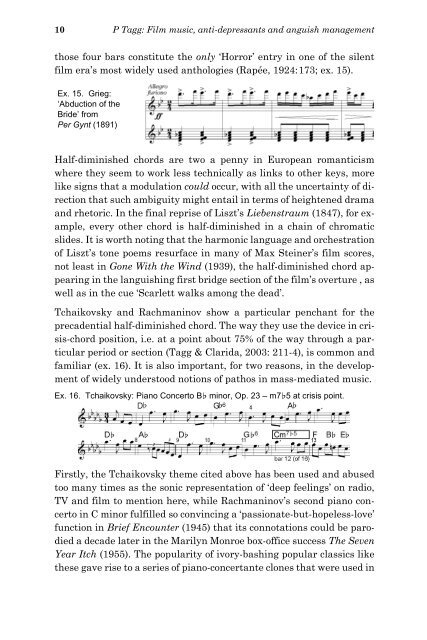Film music, antidepressants and anguish management - Philip Tagg
Film music, antidepressants and anguish management - Philip Tagg
Film music, antidepressants and anguish management - Philip Tagg
You also want an ePaper? Increase the reach of your titles
YUMPU automatically turns print PDFs into web optimized ePapers that Google loves.
10 P <strong>Tagg</strong>: <strong>Film</strong> <strong>music</strong>, anti-depressants <strong>and</strong> <strong>anguish</strong> <strong>management</strong><br />
those four bars constitute the only ‘Horror’ entry in one of the silent<br />
film era’s most widely used anthologies (Rapée, 1924:173; ex. 15).<br />
Ex. 15. Grieg:<br />
‘Abduction of the<br />
Bride’ from<br />
Per Gynt (1891)<br />
Half-diminished chords are two a penny in European romanticism<br />
where they seem to work less technically as links to other keys, more<br />
like signs that a modulation could occur, with all the uncertainty of direction<br />
that such ambiguity might entail in terms of heightened drama<br />
<strong>and</strong> rhetoric. In the final reprise of Liszt’s Liebenstraum (1847), for example,<br />
every other chord is half-diminished in a chain of chromatic<br />
slides. It is worth noting that the harmonic language <strong>and</strong> orchestration<br />
of Liszt’s tone poems resurface in many of Max Steiner’s film scores,<br />
not least in Gone With the Wind (1939), the half-diminished chord appearing<br />
in the l<strong>anguish</strong>ing first bridge section of the film’s overture , as<br />
well as in the cue ‘Scarlett walks among the dead’.<br />
Tchaikovsky <strong>and</strong> Rachmaninov show a particular penchant for the<br />
precadential half-diminished chord. The way they use the device in crisis-chord<br />
position, i.e. at a point about 75% of the way through a particular<br />
period or section (<strong>Tagg</strong> & Clarida, 2003: 211-4), is common <strong>and</strong><br />
familiar (ex. 16). It is also important, for two reasons, in the development<br />
of widely understood notions of pathos in mass-mediated <strong>music</strong>.<br />
Ex. 16. Tchaikovsky: Piano Concerto B$ minor, Op. 23 – m7$5 at crisis point.<br />
Firstly, the Tchaikovsky theme cited above has been used <strong>and</strong> abused<br />
too many times as the sonic representation of ‘deep feelings’ on radio,<br />
TV <strong>and</strong> film to mention here, while Rachmaninov’s second piano concerto<br />
in C minor fulfilled so convincing a ‘passionate-but-hopeless-love’<br />
function in Brief Encounter (1945) that its connotations could be parodied<br />
a decade later in the Marilyn Monroe box-office success The Seven<br />
Year Itch (1955). The popularity of ivory-bashing popular classics like<br />
these gave rise to a series of piano-concertante clones that were used in














